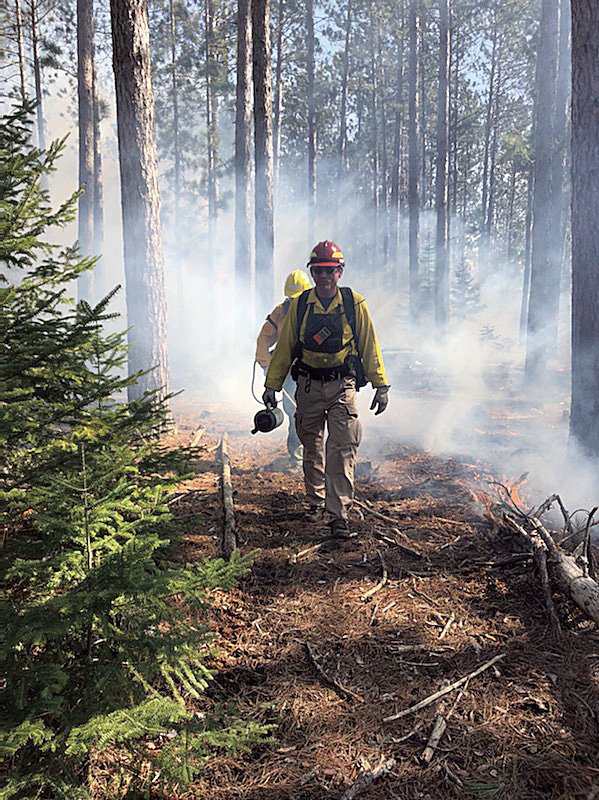Agencies in the Arrowhead like the Minnesota Department of Natural Resources (DNR) and the U.S. Forest Service (USFS) are getting ready for the approaching wildfire season. Their efforts are focused on personnel, equipment and the weather.
“Fire season is always driven by the weather,” said William Glesener, DNR Wildfire Operations Supervisor. “For 2021, we’re heading into a spring season that is on the dry side. We have abnormally dry to drought conditions noticeable throughout the state. The Arrowhead currently is abnormally dry. We have staff, both from the USFS and the DNR, that monitor the climatology and the weather to make sure that we’re prepared for switches in weather. Currently the snowpack is low. We plan for different weather scenarios and we have processes in place to identify the fire danger, and then the preparedness of our staff increases and decreases according to that weather.”
Leanne Langeberg is a Public Information Officer for the DNR based at the Minnesota Interagency Fire Center (MIFC) in Grand Rapids.
“I help to coordinate the information effort when we are in spring wildfire season and the active wildfire season,” said Langeberg.
Her job is in the nerve center for wildland firefighting, the Minnesota Incident Command System (MNICS).
Glesener described Minnesota’s overall framework for wildfire response, saying “The Fire Center [MIFC] is really the building. The decision-making, the planning, and all the day-to-day activity among the agencies in order to provide a unified response occurs through the Incident Command System [MNICS].”
In other words, the MIFC is like the body and the MNICS staff members are like the brain.
“We have three interagency incident management teams comprised of staff across all of the agencies within the state. That includes the DNR, USFS, U.S. Fish & Wildlife Service, Bureau of Indian Affairs, and National Park Service,” said Glesener.

Tim Engrav, Public Information Officer with the Superior National Forest, described personnel topics leading into fire season.
“In northeastern Minnesota our fire engines, we call them fire modules (that’s an engine and usually a chase truck with anywhere from four to eight employees) work out of our district offices. That’s Cook, Aurora, Ely, Grand Marais, Tofte and sometimes Isabella,” said Engrav. “We’re hiring our temporary employees for the summer. Our workforce in the Forest Service gets larger in the spring and summer to staff those fire modules.”
Staff members get annual firefighting refresher training and review safety topics like how to deploy a fire shelter. They also take a physical fitness test before fire season.
“It’s officially called the work capacity test, but a lot of people refer to it as the ‘pack test’ because you’re carrying a 45-pound pack. That’s for firefighters who are going to work on the fire line,” said Engrav.
Aaron Mielke, DNR Assistant Area Supervisor & Fire Program Forester based in Grand Marais, described some of the equipment preparations.
“We’ve got various kinds of Type 6, they’re the smaller fire engines that the state has a fleet of. The tanks and pumps get taken out and winterized and put in cold storage because the trucks are still used throughout the winter. We have some tracked vehicle equipment, too. Those are all gone through by mechanics to make sure they’re up to snuff before the season starts,” Mielke said. “We’re also touching base with all our local fire departments. They’re another big key player in wildfire suppression across the state.”
Aircraft play a key part in wildfire suppression. Glesener said, “We contract for aerial detection planes, helicopters, airtankers and water scoopers. We have nearly 200 DNR employees involved in wildfire aviation programs as helicopter crew members, retardant mix masters, dispatchers, and other types of resources.”
There are two main airtanker bases near the Arrowhead: the DNR base at the Hibbing airport and the USFS base at the Ely airport. The USFS has a year-round aviation presence in Ely with a fleet of Beaver aircraft. Mielke said that helicopters sometimes operate out of the Grand Marais airport. Mielke also described forward refueling points used by helicopters.
“They’re strategically located across our protection areas. Those are used in the event you get a fire in that area, and then you have somewhere that a helicopter can land to get set up to fight the fire. They can get the fuel truck in there and everything else. So, they’re operating closer to the fire than having to come all the way back to the airport,” said Mielke.
Hundreds of dedicated professionals in several organizations stand ready with their equipment keeping a watchful eye on the weather as the fire season approaches here in the Arrowhead of Minnesota.






